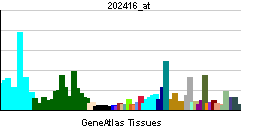DNAJC7
| DnaJ (Hsp40) homolog, subfamily C, member 7 | |||||||||
|---|---|---|---|---|---|---|---|---|---|
| Identifiers | |||||||||
| Symbols | DNAJC7 ; DANJC7; TPR2; TTC2 | ||||||||
| External IDs | Template:OMIM5 Template:MGI HomoloGene: 68306 | ||||||||
| |||||||||
| RNA expression pattern | |||||||||
 | |||||||||
| More reference expression data | |||||||||
| Orthologs | |||||||||
| Template:GNF Ortholog box | |||||||||
| Species | Human | Mouse | |||||||
| Entrez | n/a | n/a | |||||||
| Ensembl | n/a | n/a | |||||||
| UniProt | n/a | n/a | |||||||
| RefSeq (mRNA) | n/a | n/a | |||||||
| RefSeq (protein) | n/a | n/a | |||||||
| Location (UCSC) | n/a | n/a | |||||||
| PubMed search | n/a | n/a | |||||||
DnaJ (Hsp40) homolog, subfamily C, member 7, also known as DNAJC7, is a human gene.[1]
References
Further reading
- Murthy AE, Bernards A, Church D; et al. (1996). "Identification and characterization of two novel tetratricopeptide repeat-containing genes". DNA Cell Biol. 15 (9): 727–35. PMID 8836031.
- Hartley JL, Temple GF, Brasch MA (2001). "DNA cloning using in vitro site-specific recombination". Genome Res. 10 (11): 1788–95. PMID 11076863.
- Ohtsuka K, Hata M (2001). "Mammalian HSP40/DNAJ homologs: cloning of novel cDNAs and a proposal for their classification and nomenclature". Cell Stress Chaperones. 5 (2): 98–112. PMID 11147971.
- Wiemann S, Weil B, Wellenreuther R; et al. (2001). "Toward a catalog of human genes and proteins: sequencing and analysis of 500 novel complete protein coding human cDNAs". Genome Res. 11 (3): 422–35. doi:10.1101/gr.154701. PMID 11230166.
- Xiang SL, Kumano T, Iwasaki SI; et al. (2001). "The J domain of Tpr2 regulates its interaction with the proapoptotic and cell-cycle checkpoint protein, Rad9". Biochem. Biophys. Res. Commun. 287 (4): 932–40. doi:10.1006/bbrc.2001.5685. PMID 11573955.
- Strausberg RL, Feingold EA, Grouse LH; et al. (2003). "Generation and initial analysis of more than 15,000 full-length human and mouse cDNA sequences". Proc. Natl. Acad. Sci. U.S.A. 99 (26): 16899–903. doi:10.1073/pnas.242603899. PMID 12477932.
- Brychzy A, Rein T, Winklhofer KF; et al. (2003). "Cofactor Tpr2 combines two TPR domains and a J domain to regulate the Hsp70/Hsp90 chaperone system". EMBO J. 22 (14): 3613–23. doi:10.1093/emboj/cdg362. PMID 12853476.
- Gerhard DS, Wagner L, Feingold EA; et al. (2004). "The status, quality, and expansion of the NIH full-length cDNA project: the Mammalian Gene Collection (MGC)". Genome Res. 14 (10B): 2121–7. doi:10.1101/gr.2596504. PMID 15489334.
- Wiemann S, Arlt D, Huber W; et al. (2004). "From ORFeome to biology: a functional genomics pipeline". Genome Res. 14 (10B): 2136–44. doi:10.1101/gr.2576704. PMID 15489336.
- Rush J, Moritz A, Lee KA; et al. (2005). "Immunoaffinity profiling of tyrosine phosphorylation in cancer cells". Nat. Biotechnol. 23 (1): 94–101. doi:10.1038/nbt1046. PMID 15592455.
- Rual JF, Venkatesan K, Hao T; et al. (2005). "Towards a proteome-scale map of the human protein-protein interaction network". Nature. 437 (7062): 1173–8. doi:10.1038/nature04209. PMID 16189514.
- Mehrle A, Rosenfelder H, Schupp I; et al. (2006). "The LIFEdb database in 2006". Nucleic Acids Res. 34 (Database issue): D415–8. doi:10.1093/nar/gkj139. PMID 16381901.
| This protein-related article is a stub. You can help Wikipedia by expanding it. |